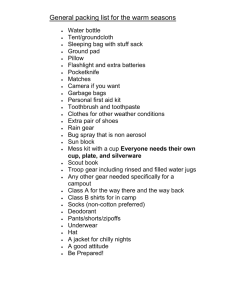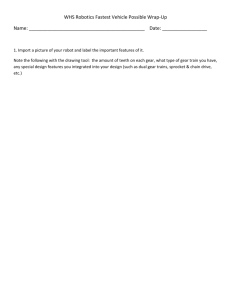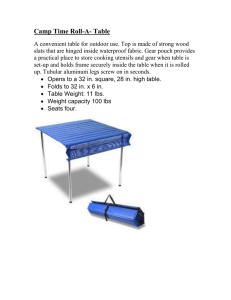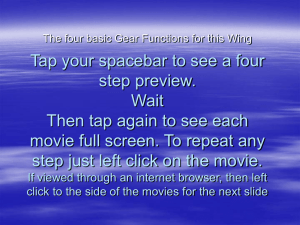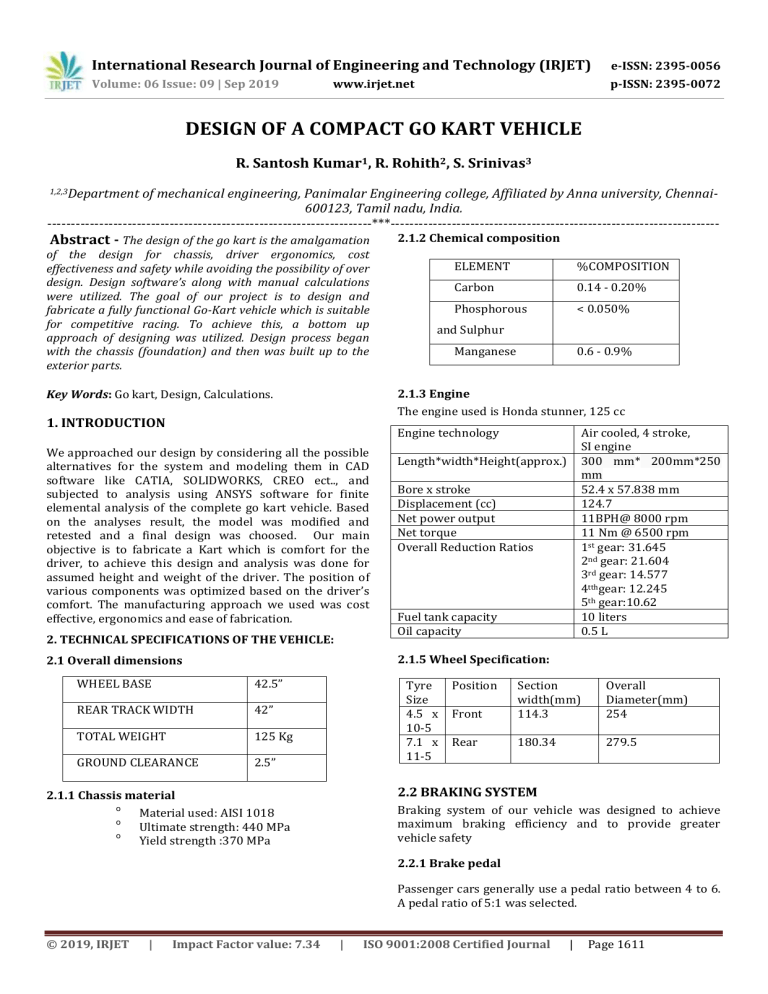
International Research Journal of Engineering and Technology (IRJET)
e-ISSN: 2395-0056
Volume: 06 Issue: 09 | Sep 2019
p-ISSN: 2395-0072
www.irjet.net
DESIGN OF A COMPACT GO KART VEHICLE
R. Santosh Kumar1, R. Rohith2, S. Srinivas3
1,2,3Department
of mechanical engineering, Panimalar Engineering college, Affiliated by Anna university, Chennai600123, Tamil nadu, India.
---------------------------------------------------------------------***----------------------------------------------------------------------
Abstract - The design of the go kart is the amalgamation
of the design for chassis, driver ergonomics, cost
effectiveness and safety while avoiding the possibility of over
design. Design software’s along with manual calculations
were utilized. The goal of our project is to design and
fabricate a fully functional Go-Kart vehicle which is suitable
for competitive racing. To achieve this, a bottom up
approach of designing was utilized. Design process began
with the chassis (foundation) and then was built up to the
exterior parts.
2.1.2 Chemical composition
Key Words: Go kart, Design, Calculations.
2.1.3 Engine
The engine used is Honda stunner, 125 cc
1. INTRODUCTION
ELEMENT
%COMPOSITION
Carbon
0.14 - 0.20%
Phosphorous
< 0.050%
and Sulphur
Manganese
0.6 - 0.9%
Engine technology
We approached our design by considering all the possible
alternatives for the system and modeling them in CAD
software like CATIA, SOLIDWORKS, CREO ect.., and
subjected to analysis using ANSYS software for finite
elemental analysis of the complete go kart vehicle. Based
on the analyses result, the model was modified and
retested and a final design was choosed. Our main
objective is to fabricate a Kart which is comfort for the
driver, to achieve this design and analysis was done for
assumed height and weight of the driver. The position of
various components was optimized based on the driver’s
comfort. The manufacturing approach we used was cost
effective, ergonomics and ease of fabrication.
2. TECHNICAL SPECIFICATIONS OF THE VEHICLE:
Air cooled, 4 stroke,
SI engine
300 mm* 200mm*250
mm
52.4 x 57.838 mm
124.7
11BPH@ 8000 rpm
11 Nm @ 6500 rpm
1st gear: 31.645
2nd gear: 21.604
3rd gear: 14.577
4tthgear: 12.245
5th gear:10.62
10 liters
0.5 L
Length*width*Height(approx.)
Bore x stroke
Displacement (cc)
Net power output
Net torque
Overall Reduction Ratios
Fuel tank capacity
Oil capacity
2.1.5 Wheel Specification:
2.1 Overall dimensions
WHEEL BASE
42.5”
REAR TRACK WIDTH
42”
TOTAL WEIGHT
125 Kg
GROUND CLEARANCE
2.5”
Tyre
Size
4.5 x
10-5
7.1 x
11-5
Position
Front
Section
width(mm)
114.3
Overall
Diameter(mm)
254
Rear
180.34
279.5
2.2 BRAKING SYSTEM
2.1.1 Chassis material
o
Material used: AISI 1018
o
Ultimate strength: 440 MPa
o
Yield strength :370 MPa
Braking system of our vehicle was designed to achieve
maximum braking efficiency and to provide greater
vehicle safety
2.2.1 Brake pedal
Passenger cars generally use a pedal ratio between 4 to 6.
A pedal ratio of 5:1 was selected.
© 2019, IRJET
|
Impact Factor value: 7.34
|
ISO 9001:2008 Certified Journal
|
Page 1611
International Research Journal of Engineering and Technology (IRJET)
e-ISSN: 2395-0056
Volume: 06 Issue: 09 | Sep 2019
p-ISSN: 2395-0072
www.irjet.net
2.2.2 Master cylinder
Analyzing the available ones, we chose the master cylinder
of TVS APACHE RTR 160. The piston diameter of this MC is
19.05 mm.
2.2.3 Caliper and rotor selection
The caliper and the rotor are selected from KTM DUKE
390 with diameter of caliper being 32 mm and effective
radius of rotor being 100 mm.
2.2.4 Brake system specifications
Brake type: Single disc brake
Brake fluid :DOT 4
Pressure developed in the system on applying the brakes,
p = FMC ÷ AMC = 2,000 ÷ 2.85*10^-4 = 7.0177*10^6 N/m2
The above pressure is same throughout the system.
Force on the calipers (FCAL) = p x ACAL = 7.0177*10^6 x
8.0384*10^-4 = 5,641.842 N
Brake Type
Recommended fluid
Brake Disc
Brake pad thickness
Master cylinder
diameter
Caliper inside cylinder
Single disc brake
Dot 4
Diameter-195
4.5mm
19.05mm
32mm
Force on the rotor / disc (clamping force) = FCAL x 2 =
5,643.842 x 2 = 11,287.637 N
Brake disc: Diameter - 195 mm
Thickness- 5 mm
Total Frictional force = clamping force x µB = 11,287.637 x
0.3 = 3,386.306 N(wet)
Brake pad lining thickness: 4.5 mm
Master cylinder diameter: 19.05 mm
Total Frictional force = clamping force x µB = 11,287.637 x
0.7 = 7,901.341 N(dry)
Caliper inside cylinder: 32 mm
2.2.6 Assuming wet surface
Assumptions:
Torque on the rotor = Frictional force x Effective rotor
radius = 3,386.306 x 0.1 = 338.6306 1N-m
Pedal ratio = 5: 1
Max force applied by the driver on the brake pedal= 400 N
Area of the Master cylinder piston (AMC) = π x (DMC)2 ÷ 4 =
π x (0.01905)2 ÷ 4 =2.85*10^-4 m2
Deceleration produced = Frictional force ÷ mass of the
kart = 3,386.306 ÷ 190 = 17.8226 m/s2
Stopping distance (from max speed to zero) = (Velocity)2
÷ (2 x deceleration) = (23.92) 2 ÷ (2 x 21.1644) = 13.51 m
+ Area of the piston in the calipers (ACAL) = π x (DCAL)2 ÷ 4=
π x (0.032)2 ÷ 4= 8.0384*10^-4 m2
2.2.7 Assuming dry surface
Effective rotor radius = 100 mm
Torque on the rotor = Frictional force x Effective rotor
radius = 7,901.341 x 0.1 = 790.13411N-m
Co-efficient of friction between the brake pad and disc,
Deceleration produced = frictional force ÷ mass of the kart
= 7,901.341 ÷ 190 = 41.38 m/s2
µB = 0.3 (wet)
Stopping distance (from max speed to zero) = (Velocity)2
÷ (2 x deceleration) = (12.76) 2 ÷ (2 x 49.38) = 6.88 m
= 0.7 (dry)
Brake fluid = DOT-4
2.2.8 Thermal analysis
Kinetic energy of the vehicle at max speed = mV2 ÷ 2 =
(190 x 23.92 x 23.92) ÷ 2 = 54355.80J
Disc diameter = 195 mm
Disc material = Cast Iron
Brake time = Stopping distance ÷ speed = 13.51÷ 23.92 =
0.564 s
Losses due to compression were neglected.
2.2.5 Brake analysis
Force on the master cylinder (FMC) = max force applied x
pedal ratio = 400 x 5 = 2,000 N
© 2019, IRJET
|
Impact Factor value: 7.34
|
Brake power = Kinetic energy ÷ Brake time = 54355.80 ÷
0.564 = 96375.53 W
Rubbing area on one side of the disc=(π÷4) x [(pad outer
diameter) 2 – (Pad inner diameter) 2]
ISO 9001:2008 Certified Journal
|
Page 1612
International Research Journal of Engineering and Technology (IRJET)
e-ISSN: 2395-0056
Volume: 06 Issue: 09 | Sep 2019
p-ISSN: 2395-0072
www.irjet.net
= (π÷4) x [(0.195)2 – (0.152) 2]
[Width of the pad = 43 mm]
= 0.01172 m2
Total rubbing area = 0.01172 x 2
= 0.02344 m2
Heat flux (q) = brake power ÷ Total rubbing area
= 96375.53 ÷ 0.02344
= 4111584.12 W/ m2
Rise in temperature of the disc while braking (T) =
= (0.527 x 4111584.126 x √0.306) ÷ √ (7250 x 500 x 58)
….[Cast Iron disc]
T = 112.22’C
Max temperature produced in the disc during hard
braking = 36.51 + 30 (ambient temperature) = 142.2’c
3.1 STEERING SYSTEM
The steering used here is based on Ackermann’s principle
in order to avoid the need for tyres to slip sideways, when
following the path around a curve.
3.1.1 Steering calculations
When a vehicle is cornering, each wheel describes a
turning circle. The outer turning circle, or its radius, is the
main subject of interest. The calculation is not precise
because when a vehicle is cornering the perpendiculars
through the centers of all wheels do not intersect at the
curve centre point (Ackermann condition). In addition,
while the vehicle is moving dynamic forces will arise that
will affect the cornering maneuver. The values stated
below were found out by using the graphical method.
NOTATIONS
STEERING GEOMETRY
WHEEL BASE
VALUES
Ackermann
1040mm
FRONT TRACK WIDTH
REAR TRACK WIDTH
DISTANCE FROM FRAME TO
WHEEL CENTER (FRONT WHEEL)
DISTANCE FROM FRAME TO
WHEEL CENTER (REAR WHEEL)
INNER STEER ANGLE
OUTER STEER ANGLE
TURN RADIUS
CASTER
TOE IN AND TOE OUT
KING PIN INCLINATION
TIE ROD
680mm
1050mm
340mm
320mm
STEERING RATIO
27degree
19.32degree
2440.155mm
1 degree
2 degrees
N/A
Equal length
340mm
1:1
STEERING ARM LENGTH
STEERING ARM ANGLE
460mm
74.22 degree
of
PERCENTAGE OF ACKERMAN STEERING ACHIEVED:
Let us assume the inner turning angle to be 27 degrees,
(A)
Now, by formula
Tan A = L/(R-D/2)
Where, L- Wheel base
D- Track width
R- Turning radius
Therefore,
Tan27= 1070/(R-680/2)
R=2440.115mm
Similarly
Tan B= L/(R+D/2)
B=18.92 degree
Steering arm angle = 4*A*tan(d/2l)
SAA=73.2degree
Now,
% Ackerman = 6*(A-B)/atan(1/(tanB-1)-B
=87.77%
Therefore,
percentage
87.77percentage
© 2019, IRJET
|
Impact Factor value: 7.34
|
ISO 9001:2008 Certified Journal
of
Ackerman
|
Page 1613
achieved=
International Research Journal of Engineering and Technology (IRJET)
e-ISSN: 2395-0056
Volume: 06 Issue: 09 | Sep 2019
p-ISSN: 2395-0072
www.irjet.net
3.1.2 Target performance of the kart
●
●
●
●
●
●
●
STUNNER 125 engine was chosen as it offers the max
power (11 BHP @8000RPM) under the 125CC
segment.
Direct drive was implemented (no jackshaft) so that
the transmission efficiency ameliorates.
When a choice was to be made between the two types
of chains (R 1278) for the drive, #R 1278 was chosen
as the load transfer capability of this chain was higher
and also the minimum breaking load is 18200 N. This
gave us a high FOS.
A small experiment was done to determine the max
force a driver can apply on the brake pedal. The
seating position was simulated and in the place of the
brake pedal, a weight machine was kept. The subject
was able to apply a maximum force of 40 Kgf or 400 N.
The target stopping distance during hard braking
from max speed (135.6 Kmph) to zero was 6 to 13 m.
To achieve this, a pedal ratio of 5:1 was considered.
The calculated stopping distance was 6.8 m under dry
conditions, which is assumed to be the track
conditions.
The effective rotor radius of the disc used is 0.1 m.
This offered higher braking torque on the disc and
thus higher braking force on the tires.
A live rear axle provides better traction when
compared to a dead rear axle. Hence a live rear axle
was used.
4.1 TRANSMISSION SYSTEM
Gear Ratio (G): 1.41[14 T clutch sprocket and 20 T axle
sprocket]
The calculations have been done for 8000 RPM crankshaft
speed as max power is available only at that speed.
Assumed total weight of the kart:
Driver
= 65 Kg
Chassis
= 15 Kg
Engine
= 30 Kg
Other stuff = 80 Kg
Total
= 190 Kg
Max angular speed of the rear wheel (N):
Gear
Reduction ratio
First gear
Second gear
Third gear
Fourth gear
Fifth gear
14.29
9.182
6.95
5.62
4.90
Speed of the
Rear wheel
(RPM)
514.8
871.62
1151.07
1423.48
1632.6
Chain: R 1278 OR 08B-1(pitch, p = 12.7 mm)
Engine: Honda STUNNER125 cc
Since the engine used has a five gear speed variation
system, some of the calculations below are done for each
gear.
Transmission:
4.2 Max Speed of the kart:
Primary reduction = 3.35
V(max)4 = (π x D x N) ÷ 60
Final reduction = 1.41
= (π x 0.28 x 1632.6)÷ 60
Secondary reduction:
= 23.92m/s
First gear
Second gear
Third gear
Fourth gear
Fifth gear
3.076: 1
1.944: 1
1.473: 1
1.19: 1
1.038:1
V(max)4= 86.122 Kmph
Similarly, for the other gears,
First gear
Second gear
Third gear
Fourth gear
Fifth gear
Rear Axle Type: live axle
Wheels: (in inches)
7.54 m/s
12.77 m/s
16.87 m/s
20.86 m/s
23.92m/s
Front = 4.5 x 10-5
4.3 Max Acceleration:
Rear = 7.1 x 11-5
a(max)1 = [g x HP] ÷ [V x weight]
Diameter of the rear wheel (D) = 280 mm [circumference
= 398.98 mm]
= [9.81 x7673.5]/ [7.54x 190 x 9.81]
a(max)1 = 5.35
© 2019, IRJET
|
Impact Factor value: 7.34
|
ISO 9001:2008 Certified Journal
|
Page 1614
International Research Journal of Engineering and Technology (IRJET)
e-ISSN: 2395-0056
Volume: 06 Issue: 09 | Sep 2019
p-ISSN: 2395-0072
First gear
Second gear
Third gear
Fourth gear
5.35 m/s2
3.162 m/s2
2.384m/s2
1.93 m/s2
Fifth gear
1.688m/s
www.irjet.net
Max plate depth (Gpl) = 11.70 mm
Transverse pitch (Pt) = -NILMax overall over joint = 20.5 mm
Bearing area = 0.50 cm2
4.4 Transmission:
Gear ratio
Weight per metre = 7 N
= 1.41
Min breaking load = 18200 N
Clutch sprocket (Z1) = 14
4.6.1 Chain velocity:
Axle sprocket (Z2) = 20
VC(max) = π x D1 x N1 ÷ 60
Engine torque (T1) = 11 N-m at 6500 RPM
= π x 0.069 x 2301.96 ÷ 60
Torque at the axle (T2) = ?
VC(max) = 8.31 m/s
Engine sprocket speed (N1) =2301.96
First gear
Second gear
Third gear
Fourth gear
Fifth gear
Axle sprocket speed (N2)=1632.6
First gear
Second gear
Third gear
Fourth gear
Fifth gear
514.8
871.62
1151.02
1423.48
1632.6
726.27 RPM
1288.9 RPM
1623.0 RPM
2007.106 RPM
2301.96 RPM
4.6.2 Chain Length:
L=Kxp
K = Constant
4.5 Pitch circle diameter of the sprockets:
Engine sprocket: 14T
D1 = p x cosec (180÷14)
K = [(Z1+Z2) ÷ 2] + [(2 x C) ÷ p] + { [(Z2 – Z1) ÷ (2π)]2 x [p
÷ C] }
= 12.7 x cosec (12.85)
Z1 = 14
Z2 = 20
D1 = 57.07mm
Axle (driven) sprocket: 20T
P = 12.7
D2 = p x cosec (180÷20)
C = 30p – 4 = (30 x 12.7) – 4 = 377 mm
…C = minimum distance between sprocket centers.
= 12.7 x cosec (9)
K = [(14 + 20) ÷ 2] + [(2 x 377) ÷ 12.7] + {[(20 – 14) ÷
(2π)]2 x [12.7 ÷ 377]}
D2 =81.18mm
D2< D (280 mm) The axle sprocket doesn’t hit the track
during operation.
4.6 Chain Drive Calculations:
K = 76.40
L = K x p = 76.37 x 12.7 = 970.28 mm
L ≈ 970 mm
R 1278 Chain specs:
4.6.3 Factor of Safety of the chain drive:
Pitch (p) = 12.7 mm
FOS =
Max Roller diameter (Dr) = 8.51 mm
Min width between the inner plates (W) = 8.00 mm
= WB ÷ W
Max pin body diameter (Dp) = 4.45 mm
For R1278 , WB = 18200 N
© 2019, IRJET
|
Impact Factor value: 7.34
|
……A
ISO 9001:2008 Certified Journal
|
Page 1615
International Research Journal of Engineering and Technology (IRJET)
e-ISSN: 2395-0056
Volume: 06 Issue: 09 | Sep 2019
p-ISSN: 2395-0072
www.irjet.net
W = Tangential force (FT) + Centrifugal force (FC) +
Sagging tension (FS)
……B
Gear
First gear
Second gear
Third gear
Fourth gear
Fifth gear
FT =
=
Overall gear Wheel
ratio
torque (N-m)
15.54
59.33
9.18
35.05
6.95
26.535
5.62
21.45
4.90
18.70
4.9 Tractive effort:
= 1096.21 N
TE = Tw ÷ (Radius of the rear wheel, R)
FC = m x v 2 = 0.7 x (8.31)2 = 48.33N
First gear
Second gear
Third gear
Fourth gear
Fifth gear
FS = k x m x g x C
….. [k = constant = 3, C =
minimum centre distance between sprockets = 0.377 m]
= 3 x 0.7 x 9.81 x 0.377
423.78 N
250.35 N
189.53 N
153.21N
133.57 N
= 7.849 N
Checking the above obtained values…
B W = 1096.21+ 48.33 + 7.849
Max tractive effort that can be applied =
TEmax = µt x
(Weight of the kart, W)
…For Asphalt, µ t = 0.7
TEmax = 0.7 x (160 x 9.81) = 1304.73 N
W = 1152.38N
A FOS =
Since the tractive effort produced in 1st, 2nd, 3rd and 4th,
5th gears is lesser than the max applicable tractive effort,
slip won't occur. There is a LESS chance for wheel slip.
= 15.79
4.7 Transmission efficiency:
4.10
Efficiency = 1 – (power lost ÷ input power)
Gradability:
Tractive effort = W x sin θ
Input power = 7673.5 W
W = m x g = (160 x 9.81) = 1570 N
Power lost = (Drag force + Rolling resistance) x Velocity
Drag force (Fd) = Cd x A x V2 x density of air ÷ 2
[A = Frontal area] = 0.7 x 0.57 x (23.92)2 x 1.16 ÷ 2
Fd = 132.41 N
Rolling resistance (Rr) = µ x W x number of wheels
=
(0.03)
x
(190
x
9.81)
x
4
[for Asphalt, µ = 0.03]
First gear
Second gear
Third gear
Fourth gear
Fifth gear
13.12 deg
7.718 deg
5.831 deg
4.703 deg
4.105 deg
5. 3D VIEWS OF THE KART
ISOMETRIC VIEW:
Rr= 223.668 N
Power lost =(132.41+223.68) x 14.07 = 5010 W
Efficiency = 1 –(5010÷ 7673.5)
= 0.3471 = 34.71%
4.8 Wheel torque
Tw = Overall Gear ratio x transmission efficiency x engine
torque
= Overall gear ratio x 0.3471 x 11
© 2019, IRJET
|
Impact Factor value: 7.34
|
ISO 9001:2008 Certified Journal
|
Page 1616
International Research Journal of Engineering and Technology (IRJET)
e-ISSN: 2395-0056
Volume: 06 Issue: 09 | Sep 2019
p-ISSN: 2395-0072
www.irjet.net
FRONT VIEW:
●
●
●
●
SIDE VIEW:
of the rod is 26 mm and 20 mm.
The priority was given to design a stable structure
with an aerodynamic arrangement in the front
part of the chassis.
A non-symmetric rear end was designed to
facilitate the engine support, driver comfort and
also provide a slight rear lift during turns.
Cross bars were used to provide uniform stress
distribution under running conditions.
Chassis was designed with only x-axis and y-axis.
The usage of z-axis was avoided to prevent
complications and to simplify the analysis
process.
5.3 ERGONOMICS
Driver ergonomics played a major role in designing of our
vehicle chassis. The cockpit has been designed to allow
considerable comfort of the driver. Large leg space and
enough room for movement inside the cockpit are some
salient points.
The approach adopted for driver ergonomics was to
question our driver on his requirements and using him as
our base for measurements, calculation and designing of
our chassis. The output has been successful design of
cockpit that is safe and comfortable with driver in. The
chassis has been designed to enhance the driver’s
visibility.
REARVIEW:
All the essential controls in vehicle have been placed such
a way that it can be accessed with ease. The accelerator,
brake pedals are positioned such that the driver shall
stretch his legs for a long time without any stress.
We have placed the kill switch near the centre of the
vehicle for easy accessand the other one in the side of the
seat.
5.1Calculation of center of gravity using CATIA
• Wide and spacious cockpit.
• Egress time: 5 seconds.
• All controls within the reach envelop of the driver’s
hand.
• The seat has been designed to withstand any kind of
sudden motion.
The center of gravity is somewhat in the engine side and
between the seat and engine.
5.2 DESIGN PROCESS :( design methodology)
●
A hollow rod was chosen instead of solid rod for
the purpose of cost reduction and better power to
weight ratio. Hence the outer and inner diameter
© 2019, IRJET
|
Impact Factor value: 7.34
|
ISO 9001:2008 Certified Journal
|
Page 1617
International Research Journal of Engineering and Technology (IRJET)
e-ISSN: 2395-0056
Volume: 06 Issue: 09 | Sep 2019
p-ISSN: 2395-0072
www.irjet.net
FLOOR PLANNING:
5.4 DIFFERENT VIEWS OF THE CHASSIS:
A. : TOP VIEW:
5.5 PROPERTIES OF MATERIAL AISI 1018:
CHEMICAL COMPOSITION
Carbon - 0.20% (max)
Phosphorous, sulphur - 0.050% (max)
Manganese – 0.6-0.9%
MECHANICAL PROPERTIES
Ultimate strength : 440 MPa
Yield strength : 370 MPa
The material has good weldability, machinability
and cost effective.
5.6 WEIGHT CALCULATION OF CHASSIS:
Total length of the rods used in design=6 m
Density of the chassis material = 7.87gm/cm3
Outer diameter of the rod = 26 mm
Inner diameter of the rod = 20 mm
Volume of the rod = [π/4] x [((26 x 10-3)2
- (20 x10-3)2) x 6]
B. ISOMETRIC VIEW:
Volume of the rod = 1.3 x 10-3 m3
Weight of the chassis =1.3 x 10-3 x 7.87 x1000
Weight of the chassis =10.23 Kg (11kg approx.)
6. CHASSIS ANALYSIS
This analysis was done in order to check the safety of the
chassis design. It was completed by conducting dynamic,
static, torsional and modal analysis over the chassis.
Deceleration after the impact was assumed to be zero
during Impact tests. Driver safety was ensured even at the
worst case. The following tests were conducted
C. PROTOTYPE:
●
●
●
●
●
●
© 2019, IRJET
|
Impact Factor value: 7.34
|
Front impact
Rear impact
Side impact
Static analysis
Modal analysis
Torsional analysis
ISO 9001:2008 Certified Journal
|
Page 1618
International Research Journal of Engineering and Technology (IRJET)
e-ISSN: 2395-0056
Volume: 06 Issue: 09 | Sep 2019
p-ISSN: 2395-0072
www.irjet.net
6.1 DYNAMIC ANALYSIS
6.1.1 FRONT IMPACT
The first analysis to be completed was that of a front
collision with a stationary object. In this case a
deceleration of 10836 N was the assumed loading.For the
front impact test, the front nodes are applied with the load
calculated. The rear is completely constrained allowing
displacement to occur only in direction of the load applied.
The maximum stress after front impact was 200Mpa. But
the yield stress of the material is 370 Mpa. So, our design
proved to be safe.
The factor of safety for the given load is calculated as 2.03
The total deformation for the given load is 2.365
The factor of safety calculated from the front impact is
1.8499
6.1.3 SIDE IMPACT
The next step in the analysis was to analyse a side impact
with a 7225.1N load.
As a side impact is most likely to occur with the vehicle
being hit by another kart vehicle it was assumed that
neither vehicle would be a fixed object. The maximum
stress after side impact was 342.19Mpa. But the yield
stress of the material is 370MPa
6.1.2 REAR IMPACT
Next rear impact analysis was done while assuming
7225.1N as the impact force.
It is same as the front impact but the rear portion was
constrained. The maximum stress after rear impact was
178.99Mpa. But the yield stress of the material is 370Mpa.
So, our design proved to be safe.
© 2019, IRJET
|
Impact Factor value: 7.34
|
The factor of safety is calculated as 1.08 for the given load
ISO 9001:2008 Certified Journal
|
Page 1619
International Research Journal of Engineering and Technology (IRJET)
e-ISSN: 2395-0056
Volume: 06 Issue: 09 | Sep 2019
p-ISSN: 2395-0072
www.irjet.net
6.2 STATIC ANALYSIS
6.3 MODAL / VIBRATION ANALYSIS:
Total load acted=95+30=125kg=125*9.81=1226.25 N
Where, weight of the driver assumed as 95 kg at the max
conditions and the weight of the engine is assumed as 30
kg.
Next for the vibrational analysis, the vibrational frequency
applied to the frame is assumed to be is 133.3HZ
calculated for 8000 rpm engine(stunner).
The weight is assumed to be acted on the specific regions
such as the driver seating and the engine mounting.
Both the deformation and the stress analysis are done for
static analysis.
The weights of the other sub systems are negligible
compared to driver’s weight and the weight of the engine.
The maximum displacement during static analysis is
1.142. and fos=5.7
The maximum displacement during vibrational analysis is
51.5mm
6.4 TORSION ANALYSIS
In torsional analysis, among four wheels three wheels are
fixed and a bumping load is acted on one wheel.
The load acted on the single wheel =9.81(chassis weight+
driver weight+ engine weight)
9.81*(30+70+15)=1275.3 N
© 2019, IRJET
|
Impact Factor value: 7.34
|
ISO 9001:2008 Certified Journal
|
Page 1620
International Research Journal of Engineering and Technology (IRJET)
e-ISSN: 2395-0056
Volume: 06 Issue: 09 | Sep 2019
p-ISSN: 2395-0072
www.irjet.net
A maximum stress of 45.812MPa is obtained.
A factor of safety of 5.45 is obtained when the load is
157.29N-m (first gear is engaged)
6.6 STATIC ANALYSIS OF STUB AXLE
The maximum deflection of the chassis during torsional
analysis is 3.219mm.
FOS=3.4
6.5 STATIC ANALYSIS OF SPROCKET
Here the inside is kept fixed. The moment of 157.29N-m
at first gear engagement is applied to the teeth that
meshes with the chain.
Here the axle part is fixed and the part attached to the
wheel is given a load about 15 kN . here this load is due to
the wobling of tires.we get quite a small amount of
deformation of about 2.5*10^3mm in the left axle.
A maximum deformation of 0.0068mm is obtained.
6.7 AXLE ANALYSIS:
In the axle analysis,the live axle of the kart is mounted to
the rear wheels. The loads and moment acting on the
axle’s end and sprocket is calculated and the results are
obtained. The moment acting on the sprocket is calculated
as 157.5N-m ( Torque transferred when first gear is
engaged ). Also the load of the kart is evenly distributed to
© 2019, IRJET
|
Impact Factor value: 7.34
|
ISO 9001:2008 Certified Journal
|
Page 1621
International Research Journal of Engineering and Technology (IRJET)
e-ISSN: 2395-0056
Volume: 06 Issue: 09 | Sep 2019
p-ISSN: 2395-0072
www.irjet.net
each wheel hub positions and its calculated as 520N on
each wheels.
A deformation of 0.4404mm maximum is obtained.
The deformation is calculated as 0.063021mm.
A maximum stress of 66.17MPa is obtained.
The maximum deformation is calculated as 74.59MPa
A maximum factor of saftery of 5.5 is obtained for a load of
400N.
ACKNOWLEDGEMENT
The factor of saftey is calculated as 4.905.
6.8 BRAKE PEDAL ANALYSIS:
In the brake pedal analysis,The force given by the driver to
the brake pedal is calculated and applied on the brake pad.
By the standards the pedal force is about 400N.Its
recommended that no more than this force is required to
stop a passengers car.since a pressure of 200N applied
othe brake and the result is observed.
The design process is not a single-handed effort and it is
our team, whom we wanted to thank for standing with us
under all circumstances. We would also like to express our
gratitude towards the Mechanical department and on the
whole towards the college for their support and also
BFKCT for providing such a wonderful opportunity to
learn and grow.
Special thanks to our Head of the Department Dr.
L.Karthikeyan
and
to
the
team
mentor
Mr.S.Dhanasekhar for their guidance and support.
7. CONCLUSIONS
The finite element analysis method is used to evaluate the
system and create and modify the best vehicle design to
achieve its goal. The main goal was to simplify the overall
© 2019, IRJET
|
Impact Factor value: 7.34
|
ISO 9001:2008 Certified Journal
|
Page 1622
International Research Journal of Engineering and Technology (IRJET)
e-ISSN: 2395-0056
Volume: 06 Issue: 09 | Sep 2019
p-ISSN: 2395-0072
www.irjet.net
design to make it more light weight without sacrificing
performance and durability also make the driver
comfortable. The result is lighter, faster and more angle
vehicle that improves go kart design.
R. Rohith
Department of Mechanical
Engineering.
REFERENCES
Fundamentals of vehicle dynamics by Thomas D.
Gillespe.
Theory of machines by R.S. Khurmi
A textbook of machine design- R.S.Khurmi and
J.K.Gupta
www.asos1.com
www.DIYgokart.com
www.Pirate 4x4.com
International Journal of Engineering Applied
Sciences and Technology, 2016 Vol. 1, Issue ISSN
No. 2455-2143
International Journal of Scientific & Engineering
Research, Volume 7, Issue 4, April-2016 429 ISSN
2229-5518 IJSER © 2016 http://www.ijser.org
DESIGN, ANALYSIS AND FABRICATION OF GOKART Kiral Lal, Abhishek
International Journal of Science, Engineering and
Technology Research (IJSETR) Volume 6, Issue 3,
March 2017, ISSN: 2278 -7798 448 All Rights
Reserved © 2017 IJSETR DESIGN OF A GO KART
VEHICLE
Milliken & Milliken, “Race Car Vehicle Dynamics”
Reza M. jazar, “Vehicle Dynamics Theory and
Applications(BBS)”
Asfan Mohiuddin, Mohd Sayeed, Md Nawaz
“Steering
System
of
Electric
Go-Kart”
International Journal for Research in Applied
Science & Engineering Technology (IJRASET)
Volume 5 Issue I, January 2017, IC Value: 45.98
ISSN: 2321-9653,Page 453-456.
.Govardhana Reddy, Md. Hameed, “design report
of a go kart vehicle”, International Journal of
Engineering Applied Sciences and Technology,
2016,Vol. 1, Issue 9, ISSN No. 2455-2143 , Pages
95- 102, Published Online July – August 2016
Dr.D.Ravikanth,Dr.K.Rajagopal,Dr.V.S.S. Murty, A.
Harikrishna, “design of a go kart vehicle”,
International Journal of Science, Engineering and
Technology Research (IJSETR) Volume 6, Issue 3,
March 2017, ISSN: 2278 -7798 ,Page 448-456.
S. Srinivas
Department of Mechanical
Engineering.
BIOGRAPHIES:
R. Santosh kumar
Department of Mechanical
Engineering.
© 2019, IRJET
|
Impact Factor value: 7.34
|
ISO 9001:2008 Certified Journal
|
Page 1623

